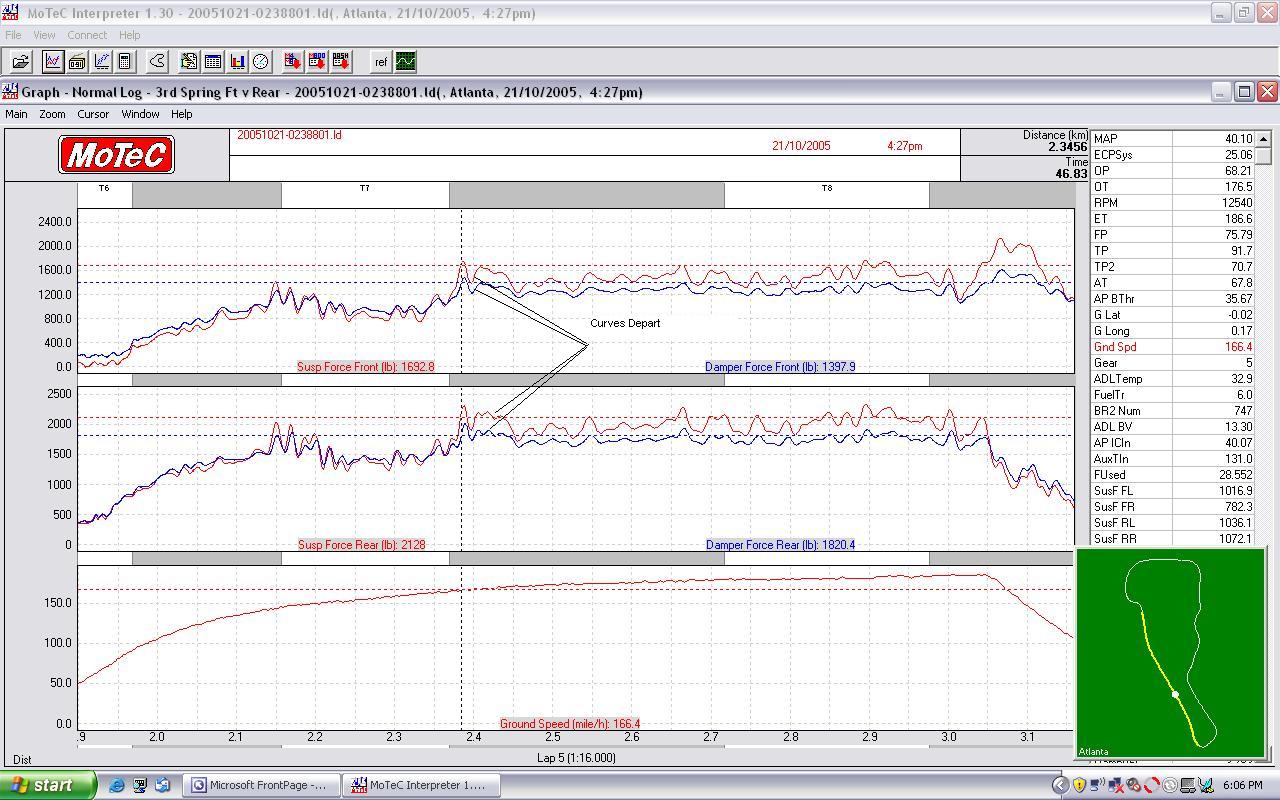
Taking the Mystery Out of the Third Spring
Iíve written elsewhere on this site that ChampCar suspension is a compromise between mechanical and aero grip. Actually, for most the road courses I run in HSR (Atlanta, Road America, Watkins Glen and the like) there is not much compromise and thus not much mechanical grip. Normally, you would want to run a car with softer springs to promote mechanical grip. Do this on a ChampCar and the downforce it generates at speed would quickly collapse the primary springs and grind the tub into the ground.
The designers at Lola have implemented a ďthird springĒ in addition to the two primary springs on the front and rear of the car to address this problem. This third spring allows the use of softer primary springs which function at lower speeds with the third spring coming into play when speeds increase and the chassis is blown down towards the track. I run third springs in the 3500 lb/in range while primaries are more like 1800 front and 1200 rear.
Most people that run these cars in historic racing will warned me about running third springs. Basically, they said donít. The primary concern was the need for data to tell you when your ďonĒ the third spring. It is important to land on third springs at a higher speed than your fastest corner. The idea being that you do not want to introduce a change in spring rate during a corner. For example, if you hit the third spring at 150 mph, turn into a corner at 155 mph and apex at 146 mph then you will transition off the third spring during the corner thus potentially changing the carís balance mid-corner. I had no desire to learn of such things the hard way and thus avoided third springs until I had both damper travel and pushrod load sensors in place and working. By that time I also was very comfortable with how the tub moved with aero loading and had good baseline ride heights for most tracks.
I set my data acquisition up to calculate and display wheel force for each corner based on both the primary damper spring compression and the direct display of pushrod loads. I check the third spring settings for both the front and rear during the first track session (before I even get up to speed on the corners) by doing a full speed run down one of the straights. It is very easy to see how the primary spring generated wheel load and the pushrod wheel load follow each other right up until the suspension lands on the third spring. Once the third spring is touched, the pushrod loads continue to rise much more aggressively than the primary damper spring generated loads so the curves depart. Iíve got an example below. You simply increase or decrease the gap before the suspension compression starts to compress the third spring thus adjusting when you land on the third spring as you gain speed. Once set up, my third spring configuration has stayed pretty much the same. I check it at every track but seldom adjust the gaps.

One interesting side note involves just how far a ChampCar chassis moves to come into contact with the track. The damper travel sensors let me look at how far the dampers compressed and thus how far the hub had moved with respect to the chassis when the car had touched down. Roughly 50% of the tub travel towards the track is accomplished by damper compression while the other half is tire sidewall compression. This is a bit of a shame as sidewall compression is not controlled by the dampers which reduces the affect of shock adjustments.
Apparently the Goodyear historic ChampCar tire has significantly softer sidewalls then the tire originally run on the cars. This became very obvious when I watched a professional team try to run a 99 Swift for the first time in historic racing. I was in the pits before the cars went out admiring the carbon work on the Swift when I made a comment about how low they were running the car. Their response was a quick quip about how the car held the outright track lap record at the track (Road America) and they knew perfectly well what they were doing. The driver promptly wore right through the jab-roc, the underwing and straight into the tub on his first outing. I think they figured it out after that.
|
|
|||